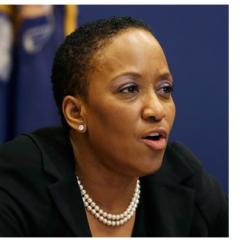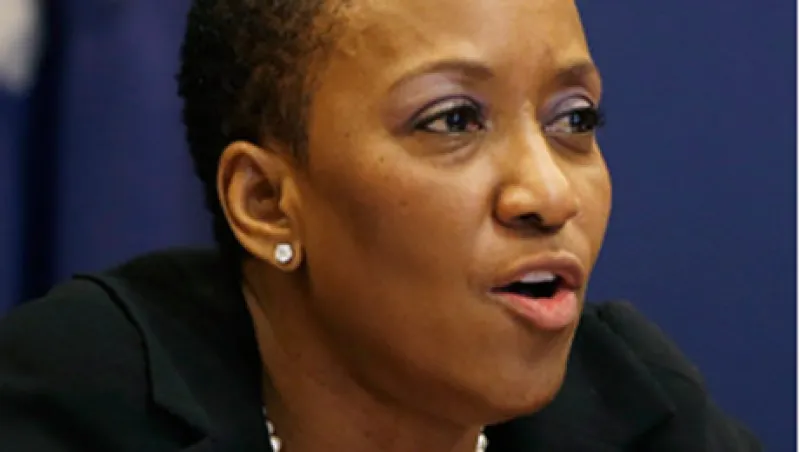Many people in the financial world start their working lives in public service as a stepping stone to a lucrative career in asset management. But not Vicki Fuller. In August 2012 she traded a 30-year career in asset management for the life of a public servant. Now, instead of working for shareholders and investment clients, Fuller, in her new role as chief investment officer at the New York State Common Retirement Fund, the third-largest U.S. public pension fund with $160.4 billion in assets, serves 1 million state and local employees, retirees and beneficiaries. In her first year on the job, she has drawn on her past roles investing in emerging markets debt and servicing some of the largest U.S. pension funds.
Fuller’s journey to public pension official began in Chicago’s inner city, where she was raised. At Chicago’s Roosevelt University, the philosophy major added a second major in accounting at the urging of her mother, a bookkeeper. Next came an MBA from the University of Chicago with a concentration in international finance and marketing. After her 1981 graduation, Fuller left the Windy City for the Big Apple and a career in finance, starting as an associate with Morgan Stanley, then moving on to Standard & Poor’s.
"I cut my teeth analyzing companies that took on a lot of debt but were otherwise profitable," says Fuller, 56, who in 1985 was recruited to Equitable Capital Management, which later merged with Alliance Capital. At Equitable, she delved into a new arena that in the 1980s wasn’t yet considered a bona fide asset class: noninvestment-grade securities.

|
| New York State Common Retirement Fund CIO Vicki Fuller. Photo: Mike Groll/Associated Press |
Searching for a career change in 2005 and still at the firm that had become AllianceBernstein (when Alliance Capital acquired Sanford C. Bernstein in 2000), Fuller accepted a position in client service after overcoming her initial concern that the job meant taking people to football games. Her new role put her in front of officials at the largest U.S. public pensions, including those at New York Common in Albany and New York City.
“I believe that many of the public funds need to talk to someone who isn’t selling, who brings serious investment perspective to the equation,” she explains. “It raised the level of discussion from what are you doing in private equity and fixed income to what are the issues a plan sponsor faces.”
As her first anniversary at the New York State pension fund approaches, Fuller invited Institutional Investor Senior Writer Frances Denmark into her midtown office to discuss the challenges of investing pension assets and the future of defined benefit plans.
What attracted you to the CIO role at the New York State Common Retirement Fund?
I liked the impact of decisions, the multilayered analysis one engaged in and the uncertain environment. One of the things that is attractive about this plan is it has a sole trustee. In my client service role, it was easier for me to interact with plans when the decision-making wasn’t so diluted and uncertain, and sole trustees offered that. You knew that the person you were talking to had the ability to make changes to make an impact.
Describe the portfolio you inherited.
We are currently completing an asset allocation that was instituted in 2009. It recognizes that you need to be in public equities. When it’s done we’ll have 43 percent in domestic and international equities. We can be up to 70 percent. We’ve taken the 70 percent and allocated 40 to public equities with the balance in private equity and real estate, hedge funds, opportunistic strategies and real assets.
The allocation makes smart use of the legal basket we have. The basket, or legal list, allows up to 25 percent of nonlegal-list securities. That’s where we can make use of the alternatives, domestic equity and core fixed income.
Which alternatives are in the portfolio?
There is a 3.2 percent allocation to hedge funds. We have a real asset bucket [up to 3 percent] meant to be an inflation protection strategy although it has an alternatives bet — infrastructure, timber, agricultural land — things that are higher yielding. We are just starting to invest there. The allocation to opportunistic strategies [0.2 percent] are things that don’t fit into hedge funds or private equity.
Has investing gotten harder?
Yes, and maybe that always happens after a crisis. What’s made it complicated is the aftermath of 2008 coupled with pension plans that did not make their pension contributions. It wasn’t just because the equity market imploded; it was also bad if you weren’t funded well. Post-crisis we have been looking for ways to diversify risk while keeping our rate of return assumptions intact in an environment where Federal Reserve-induced rates are essentially zero. The hardest thing to do is to continue to invest for the long term. I don’t believe you can diversify equities out of your portfolio and still hope to have the ability to meet your requirements.
What is your view on portfolio diversification?
For a while there was a discussion in the pension world about following the endowment model that has very little equity beta. Endowments replaced it with big allocations to hedge funds and private equity. But public equity is a large, liquid market place where an investor can access the largest companies in each sector and can control the names in the portfolio. The liquidity allows you to sell into market rallies and buy on market dips. You can’t do this with private equity. However, private equity allows an investor to access smaller or broken companies. Success is contingent on partnering with general partners with the ability to transfer these companies into those that generate a performance premium over public equity. Hedge funds are interesting but returns aren’t high enough to be the place where you allocate the lion’s share of your assets. I suspect if endowments’ payout rate is 5 percent it may work. But if you want to have any hope of meeting your pension obligations on a sustainable basis, it’s hard to see how you wouldn’t have meaningful allocations to equity.
Where do you look for investment opportunities?
Many people spend a lot of time talking about alternatives as a panacea. I take another approach. I think alternatives provide another dimension. But I ask myself the basic questions. In core fixed income — the anchor to windward in a portfolio — are we investing smartly there? Are we making use of all the different asset classes? Are we thinking smartly about what we should do with Treasuries or agencies, the kind of corporate bonds we buy? I believe in being smart about your basic building blocks, fixed income and equity, because they’re going to have to carry a lot of the water.
I believe in global versus having discrete allocations to international and domestic — that’s a change we will be migrating toward. If large-cap domestic equities are very efficiently priced and you can’t generate return above your benchmark, that allocation should be passively managed. That still means we should spend judicious time trying to find managers and strategies in equities that have shown the ability to generate alpha. It’s not that all large-cap equities should be passive; that’s a default position. It takes more effort to find those who can generate alpha. What we’ll be doing is rolling it all up and making sure equities, fixed income and alternatives are all additive. Alternatives aren’t going to be the panacea if we don’t invest smartly in equities and fixed income.
What is the future of employer-sponsored retirement income plans?
I don’t think defined contribution is the solution. The debate about defined benefit versus defined contribution is a spurious one.
How so?
I’ve seen public funds try to institute a defined contribution plan or move to a balanced plan with elements of both defined benefit and defined contribution. The thing that concerns me the most is when state pension officials spend lots and lots of time with decisions such as which target date funds to select. I found one size doesn’t fit all. Where the worker is given any discretion, they pick the wrong target date fund, or a target date fund and fixed income, or worst of all, a stable income option because they think it is safe.
I learned that if a person has a defined benefit plan, they can take a little risk. If all that people have is a defined contribution plan and they misallocate that and don’t have money to retire on, we’ll end up with a national crisis.






